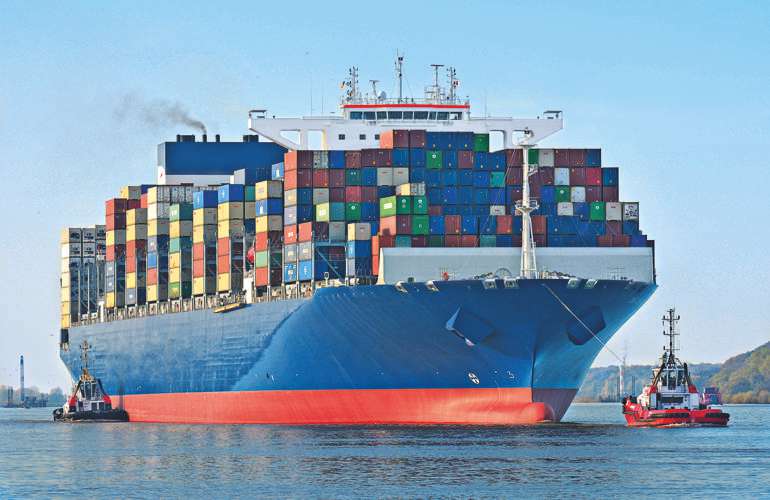The vital role played by tugs when ships enter and leave the port is not always given its due. But they are an indispensable part of the logistics chain. And it’s not only large freighters that rely on them.
A tug has about 7,000hp and allows between 60 and 95 tonnes of bollard pull, i.e. maximum pulling power in relation to a fixed object. Building one from scratch costs from €4m.
They hardly ever work alone. Harbour tugs are real team players. Usually two to three of them join forces to escort a cargo ship as it enters and leaves the port. The crews of these tugs coordinate among themselves and with the captain and port authorities. With their powerful engines, the tugs work alongside both larger and smaller craft. Ships depend on the assistance of tugs, but for safety reasons the tugs musn’t get too close to the carriers, although if there is a storm so strong that it could prevent ships from docking, contact may be necessary. Contrary to what their name suggests, these workhorses can not only tow, but also push. For this purpose, the cargo ships are specially reinforced at certain points and marked accordingly.
Part of port logistics
At Boluda Towage Europe, port towage is their principal market. Its subsidiary Unterweser Reederei (URAG) was founded in Bremen in 1890 and was bought by the Spanish shipping company Boluda Corporación Marítima in 2016. Since Boluda Towage also took over the Dutch joint venture Kotug Smit Towage in 2019, combining German activities under the brand name Boluda Towage Europe, the company has been serving ten seaports in Germany with 27 port tugs: Wilhelmshaven, Bremen, Elsfleth and Brake as well as Nordenham-Blexen, Bremerhaven, Cuxhaven, Stade, Wedel and Hamburg. In addition to the ports in Germany, Boluda Towage Europe operates a fleet of eighty tugs in the Netherlands, Belgium and the UK.
“A typical operation of our port tugs starts with the ship’s arrival notification via the National Single Window,” says Michael Neie, commercial area manager at Boluda Towage Europe. Through the traffic flow plans published by the port authorities, the tugboat company then knows which ship will arrive when and, if it is subject to tugboat duty, which agent will take care of it. “Since we know the agents, we can usually work out which shipping company the ship is sailing for and whether we are working with them.”
The time of the ship’s call that is sent to the tug is initially quite vague. “First of all, we look at the information from the HBH, i.e. the Bremen Port Authority, and the pilot lists so that we know when the pilot is going on board.” The pilot is also the one who knows the area best and can judge the number of tugs necessary for a manouvre, taking into account the weather conditions.
Depending on local conditions, the specifications for the number of tugs required may vary from port to port. A Panamax vessel may need up to five tugs in Bremen’s industrial port, but only three in Brake. A Triple-E-class container ship with a capacity of more than 18,000 TEU (20ft standard containers) usually needs three tugs, whereas RoRo ships need two each for entering and leaving Bremerhaven.
Facts
Boluda Towage Europe
Founded:
• Unterweser Shipping Company 1890
• Kotug Germany (later Kotug Smit) 1996
Takeover by Boluda: 2016 and 2019
Location in Germany: Bremen
Head office: Rotterdam
Business areas: harbour tugs, offshore and ocean towage, salvage and aid, special projects
Number of ships: 28 (27 port tugs and one sea tug), more than 300 worldwide
Ports in Germany: Wilhelmshaven, Bremen, Elsfleth, Brake, Nordenham-Blexen, Bremerhaven, Cuxhaven, Stade, Wedel and Hamburg
Employees in Germany: over 200

The number of tugs varies according to local conditions. For large Triple-E class container ships with 18,000 TEU, three tugs are usually required.
In order to be prepared for future ship sizes, Boluda works closely with port authorities and pilots and, for maiden voyages, jointly simulates the calls in the simulator. The captain – and, indirectly, the pilot – can deviate from the minimum number. “The requirement also depends on which side the ship docks and whether it has to be turned,” says Neie. “Other factors are the weather, the current and the draught, but also ship-specific issues like the strength of the bow thruster.”
Since tug availability must be guaranteed when the ship enters the Weser, tugboat combination is planned well in advance and coordinated with the pilot if necessary. The shipping company then has about half to three quarters of an hour to take over the ship at the tug position. “In Bremerhaven, that’s buoy 49 at the end of the riverside quay,” says Neie. On site, the tug captains coordinate the basic manouvre with the pilots, negotiating whether the ship is to be turned around and which tug is to support which ship. Communication is via a dedicated radio channel, with the pilot being the conductor. It can be quite a challenge to distinguish between the babble of voices.
Constantly on board
When the ship leaves the port, communication for the tugboat operation takes place between the shipping company agents. “As soon as the loading and unloading is completed, the agent gives us a rough departure time,” says Neie. “Two hours before departure, the provisional order is confirmed.”
The tug lines are attached via hawseholes, i.e. openings in the bulwark of the ship’s side. From the deck of the ocean-going vessel, the sailors then throw down a throwing line weighted with a monkey fist (a kind of braided tennis ball to which the retrieval line and the towing gear are attached). After the towing line is pulled through the hawsehole, the line is attached to the bollard.
The towing manouvres themselves are fairly straightforward. “It’s not rocket science,” says Neie, “but of course good seamanship and a basic understanding of physics are required.” It could be dangerous for man and ship. A wrong manouvre or going too fast could lead to the tug being run over, and tow lines can break. “This is a high-risk job, you can’t forget that,” says Neie. Good communication is vital and demands on the crew are strenuous. Anyone who steers a harbour tug must have a captain’s license and six months’ experience. The requirements of tugboat captains differ from port to port, so Boluda tries to train them for as many ports as possible. Candidates are initially deployed as helmsmen on deck, and then they have to gain sailing experience.
Contrary to expectation, the crew is on board for the duration of their service. Attendance is compulsory. Normally there are three people: a captain, an engineer and a sailor. “There are either seven/seven or fourteen/fourteen shifts, which means that the crew works either seven or fourteen days continuously and then has the same number free,” says Neie. “In autumn and during storms the daily workload is of course higher because more tugs are needed.” When the tugboat is not in operation, the crew services the ship, for example with maintenance, charts and documentation. There are separate sanitary facilities or shared showers on board, depending on the type of ship. Crew members feed themselves. During time spent on board, a short shopping trip is the only reason to go ashore, apart from emergencies. “The crews are like small families,” says Neie. “Esprit de corps and good teamwork are essential.” (cb)







